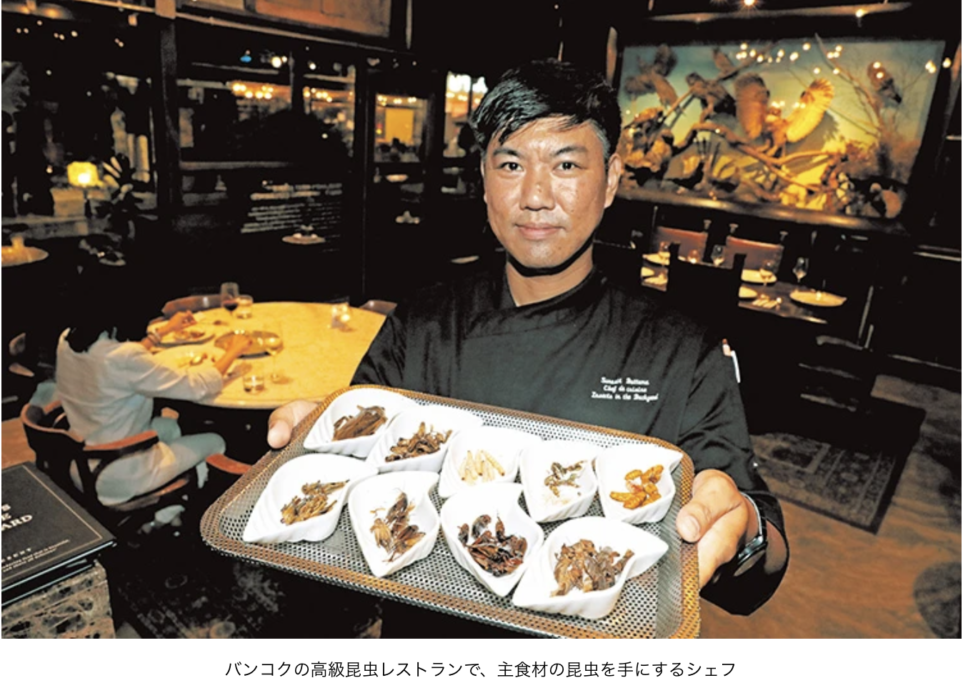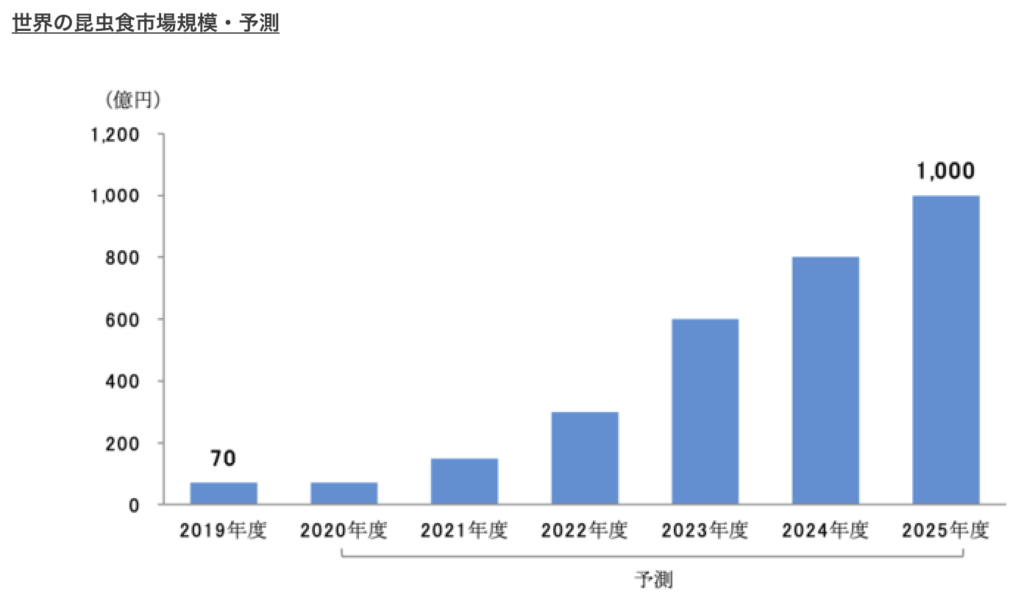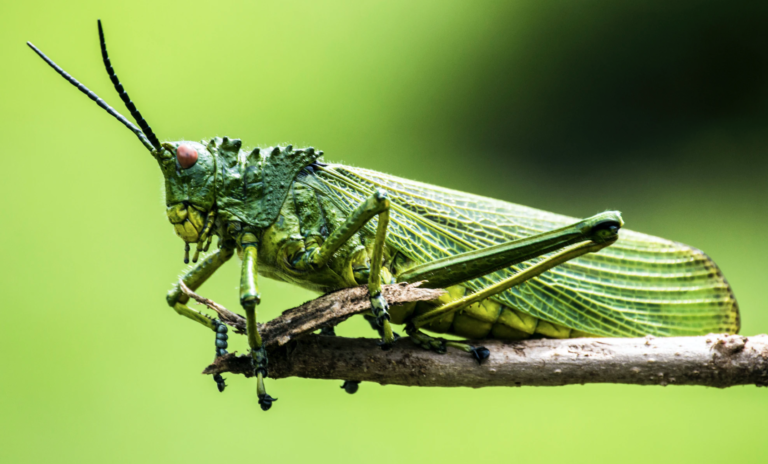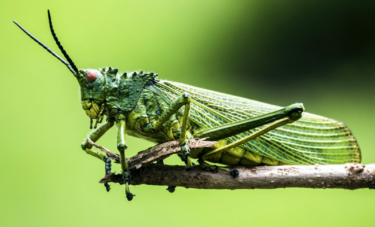はじめに
NHKのサイエンスゼロを見ていたら、2月6日に「もうムシできない!“昆虫食”が世界を救う」という特集をしていた。昆虫食が気になって、TED-Edで検索したら出てきた。日本でも昔から昆虫を食べる習慣がある地方もあるし、ネットで検索すると昆虫食の自動販売機も設置されていた(出典)。こおろぎを450円で買って食べる人がどれほどいるのかは疑問だけど確かに気になるトピックだ。興味のある方はまずは下の動画を見てほしい。
(出典:YouTube)
昆虫と昆虫食
高級昆虫食レストラン
昆虫食というとゲテモンだ。テレビでもアイドルたちが罰ゲームとして虫を食べるシーンがあったりする。昆虫食が注目されるきっかけは、FAO(国連食料農業機関:Food and Agriculture Organization of the United Nations)が2013年に食料問題の解決策として取り上げられたことだ。これに続いてEUが2015年に新規食品(Novel Food)に昆虫を規定した。どんな昆虫でも食べて良いわけではない。承認された昆虫であればEU内で販売できるようになり、世界の少量昆虫市場が急拡大するきっかけになった。タイでは昆虫食を売り物にする高級レストランまで出てきた。びっくり。

(出典:Globe+)
世界の昆虫食市場規模と予測
2019年度の昆虫食市場は70億円ほどだけど、2025年度には約1,000億円規模と14倍、年率換算では1.55倍に増大すると予測されている。これは、生産時の環境負荷が少ないためSDGsの文脈からも注目されている。最大のネックは見た目だけど、加工製品の原料とすることで新製品の開発や販売が進むと見込まれている。確かにお煎餅や麺類の原料にすれば、見た目を気にせず美味しく頂けるかもしれない。
(出典:PR TIMES)
世界の主な食用昆虫
昆虫を食べたことのある人は少ないだろう。自分は、香港に赴任していた時に何か昆虫のようなものの佃煮系を出されて、食べたことがあるけど、味は正直よくわからなかった。現在、世界では約20億人が1900種以上の昆虫を食しているようだ。特に多いのが黄金虫のような甲虫類(31%)だ。毛虫などの幼虫(18%)や、ハチやアリの仲間(14%)、さらにはイナゴ・コオロギなどのバッタ類(13%)などだ。昆虫食が注目される背景は世界の人口が2030年には90億人に達すると見込まれており、それを支える食料を家畜に求めると環境破壊が進むという危機感がある。

(出典:Foods Channel)
9つの質問
実施にTED-Edの動画を視聴すると、理解度を確認する質問に回答することができる。基本的な質問から高度な質問まである。以下の記載は私の回答であり、これが正解ということではないですが、考えるヒントになれば幸いだ。
Q1) How many people eat bugs worldwide?
これは20億人だと思う。
Q2) The ___________ historically enjoyed beetle larvae.
動画の中では、「古代ギリシャではセミは贅沢なおやつとされていた。ローマ人はカブトムシの幼虫をおいしいと思ったそうだ」などと説明されていたので、「The Romans」を選択した。ビートルズといえば、1960年代に大ブレイクしたロックバンドだけど、意味はカブトムシとか甲虫の意味で、larvaeは幼虫だ。ローマ時代から食べられていたとはびっくり。ローマ時代やギリシャ時代に確かに食糧としていたようだ。ただ、結構でかい。まるで昔見た映画のモスラーそのものだ。
Q3) When did our attitude towards eating bugs begin to change?
これは動画の中で「紀元前1万年頃、農業の発祥の地である中東の肥沃な三日月地帯から始まった」ような説明があった。1万年もまえのことをどうやって確認するのだろう。日本では縄文時代が1万年以上続いたけど、その当時ももしかしたら昆虫を食糧としていた可能性もありそうだ。
Q4) How many different insect species do people eat around the world?
TOEFLもそうだけど、こういう基本的な数字は忘れる前に素早くメモしておく方が無難だろう。動画の中では2,000以上の昆虫の種類と説明していた。ネットでは1900種以上と書かれているが、まあ誤差範囲だろう。
Q5) Which part of the world currently eats insects the most?
動画の中で「熱帯地方の国々は昆虫食を文化的に受け入れられ、熱心に消費している。熱帯地域の昆虫は大型で種類が多く、群れをなして生息している。」などと説明していた。このため、与えられた選択肢の中の「Countries in the tropics」とした。
Q6) Some insects are made of up to 80% protein.
実はこれは少し悩ましかった。なぜかといえば、動画の中で「昆虫のタンパク質は最大80%」と言いながら、別のパラグラフではアメリカ原産のカブトムシの幼虫は養殖が容易で、ビタミンが豊富で、健康的なミネラルも多く、タンパク質は最大50%と言っている。ただ、設問を見ると昆虫によっては最大80%のプロテインを含むと控えめな表現なので、答えはYESだと思った。
Q7) List some creative ways for changing people’s perception of bugs as pests.
この後は選択式ではなく記述式となる。これはどれが正解ということはなく、回答者の意見として述べることになる。例えば、次のような感じだろうか。
Two billion people in the world use insects in their diet. They fry them, stew them in sauces, and dry and salt them. In addition, insects are highly nutritious and good for your health. They can also be raised by feeding on food that would otherwise have been discarded. They use very little water resources and emit far fewer greenhouse gases.
Q8) What negative environmental impacts could be associated with foraging for and farming bugs?
環境に優しいという文脈での動画だったので、環境へのマイナス面での影響というとなんだろう。サイエンスゼロで指摘されていた課題を少し書いたけど、求められているものとちょっと違うかもしれない。
Farming worms can provide a nutritious source of food. Furthermore, it has much less impact on the environment than raising cattle or pigs. In addition, the fact that rearing is also a lightweight process is easy to utilize in developing countries. The negative impact on the environment is the unintentional outflow and spread of the insects being raised, and sufficient response and attention to this is required.
Translated with www.DeepL.com/Translator (free version)
Q9) How could insect farming address some of the problems associated with food insecurity?
「insecurity」とは不安定だ。securityは安全なのに、その反対語が不安全ではなく不安定となる点はちょっと面白いと思った。要は昆虫食の養殖を進めるにあたっての不安は何かという設問と理解した。なんだろう。次のような回答を想定した。
The benefits of efficient production of nutritious food in developing countries with poor food conditions are significant. In developed countries as well, it is gaining attention as a healthy food with high nutritional value such as protein, and is expected to take root in the future. However, measures to solve problems such as the suppression of allergic reactions are still required.
昆虫食の未来と課題
サイエンスゼロでは、将来人類が宇宙に飛び出すときに、家畜を運ぶのは大変だけど、昆虫なら運搬も容易だという説明があった。宇宙飛行士の健康を維持するための貴重なタンパク質の補給に役立つのかもしれないと思った。また、昆虫を活用することで、廃棄している食品の有効活用や魚類の養殖の餌としての活用など、今後の社会に有効なエコシステムを構築できるとすればそれこそ素晴らしいことだと思った。

(出典:昆虫食のセミたま)
まとめ
今回は昆虫食についてのトピックを選択した。カブトムシの幼虫を飛べると思うと、正直気持ち悪い感覚はあるけど、これらの営業分を姿を変えて加工食品の原料に活用するのはアリかと思う。ただ、アレルギー体質への配慮や十分な検証や検査は必要だと思った。
以上
最後まで読んで頂きありがとうございました。
拝
参考:英文スクリプト(聞き取り版)
For centuries, people have consumed bugs, everything from beetles to caterpillars, locusts, grasshoppers, termites, and dragonflies. The practice even has a name: entomophagy. Early hunter-gatherers probably learned from animals that foraged for protein-rich insects and followed suit. As we evolved and bugs become part of our dietary tradition, they fulfilled the role of both staple food and delicacy.
In ancient Greece, cicadas were considered luxury snacks. And even the Romans found beetle larvae to be scrumptious. Why have we lost our taste for bugs? The reason for our rejection is historical, and the story probably begins around 10,000 BC in the Fertile Crescent, a place in the Middle East that was a major birthplace of agriculture. Back then, our once-nomadic ancestors began to settle in the Crescent. And as they learned to farm crops and domesticate animals there, attitudes changed, rippling outwards towards Europe and the rest of the Western world.
As farming took off, people might have spurned bugs as mere pests that destroyed their crops. Populations grew, and the West become urbanized, weakening connections with our foraging past. People simply forgot their bug-rich history. Today, for people not accustomed to entomophagy, bugs are just an irritant. They sting and bite and infest our food. We feel an “ick factor” associated with them and are disgusted by the prospect of cooking insects.
Almost 2,000 insect species are turned into food, forming a big part of everyday diets for two billion people around the world. Countries in the tropics are the keenest consumer because culturally, it is acceptable. Species in those regions are also large, diverse, and tend to congregate in groups or swarms that make them easy to harvest.
Take Cambodia in Southeast Asia where huge tarantulas are gathered, fried, and sold in the marketplace. In southern Africa, the juicy mopane worm is a dietary staple, simmered in a spicy sauce or eaten dried and salted. And in Mexico, chopped jumiles are toasted with garlic, lemon, and salt. Bugs can be eaten whole to make up a meal or ground into flour, powder, and pasted to add to food. But it is not all about taste.
They are also healthy. In fact, scientists say entomophagy could be a cost-effective solution for developing countries that are food insecure. Insects can contain up to 80% protein, the body`s vital building blocks, and are also high in energy-rich fat, fiber, and micronutrients like vitamins and minerals.
Did you know that most edible insects contain the same amount or even more mineral iron than beef, making them a huge, untapped resource when you consider that iron deficiency is currently the most common nutritional problem in the world? The mealworm is another nutritious example. The yellow beetle larvae are native to America and easy to farm. They have a high vitamin content, loads of healthy minerals, and can contain up to 50% protein, almost as much as in an equivalent amount of beef. To cook, simply saute in butter and salt or roast and drizzle with chocolate for a crunchy snack.
What you have to overcome in “ick factor”, you gain in nutrition and taste. Indeed, bugs can be delicious. Mealworms taste like roasted nuts. Locusts and similar to shrimp. Crickets, some people say, have an aroma of popcorn. Farming insects for food also has a less environmental impact than livestock farms do because insets emit far less greenhouse gas and use up less space, water, and food. Socioeconomically, bug production could uplift people in developing countries since insect farms can be small-scale, highly productive, and yet relatively inexpensive to keep. Insects can also be turned into more sustainable food for livestock and can be reared on organic waste, like vegetable peelings, that might otherwise just end up rotting in landfills.
Feeling hungry yet? Faced with a plate of fried crickets, most people today would still recoil, imagining all those legs and feelers getting stuck between their teeth. But think of a lobster. It is pretty much just a giant insect with legs and feelers galore that was once regarded as an inferior, repulsive food. Now, lobster is a delicacy. Can the same paradigm shift happen for bugs? So, give it a try! Pop that insect into your mouth, and savor the crunch.




